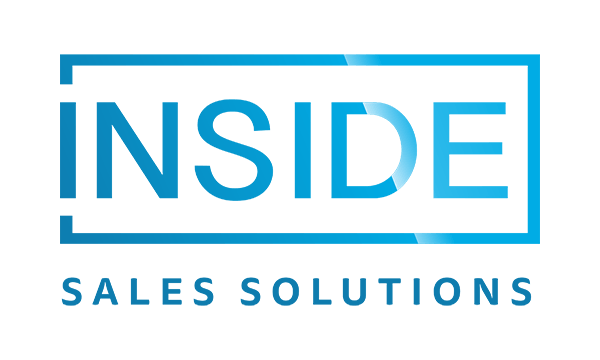We get asked all the time,“What is the secret to winning top accounts?”
The most common answer, Account Based Marketing (ABM). But is that really the best answer for your company?
While ABM can be extremely successful and has become one of the most popular strategies for companies today, it is by no means the only strategy for targeting and closing top accounts through the alignment of sales and marketing.
In this guide, we’ll help you determine whether ABM is the right strategy for you, how to get started if it is, and six alternative strategies to consider if it’s not.
What’s Inside:
- Account Based Marketing
- Sales and Marketing Alignment: The Strategy Behind Your Strategies
- 6 More Strategies to Win Top Accounts
- Paid Ads: Putting Your Money Towards Top Results
- Directing Your Outreach and Calling Strategies Towards Key Accounts
- Social Media Marketing: Connecting with Top Accounts
- Finding the Right Inbox for Your Email Marketing Strategy
- Attending and Hosting the Events Your Key Accounts Care About
- Optimizing Your SEO Strategy for Real Results
Want to share this guide or save it for later?
Account Based Marketing
According to the 2020 State of ABM Report a staggering, “94.2% of respondents currently say they’ve got an ABM program.”
However, it’s important to note, 51% of those respondents are still in the pilot or early stages of their ABM strategy, having not fully integrated a cohesive ABM strategy and subsequent marketing and sales alignment.
What does that tell us? While the concept of ABM is extremely popular (and many companies claim to have an ABM strategy) the strategic application is a little more wishy-washy.
So, what exactly is ABM? And how do you do it successfully?

What is Account Based Marketing?
Account Based Marketing is a hyper-personalized marketing strategy which targets top accounts with customer-specific messaging and collateral focused solely on that account’s specific pain points, needs, and core business challenges.
The lynchpin of ABM is the sole focus on one specific account per campaign. If you find yourself using the exact same landing page for multiple accounts, chances are your strategy might be highly targeted, not truly account-based.
And you wouldn’t be alone.
Because while today many companies find themselves compelled to take part in the fanfare of ABM, in fact, what often occurs is a more generalized targeting of accounts that isn’t quite ABM.

What ABM Isn’t:
- Personalized marketing
- Industry-specific marketing
- Customer lifecycle marketing
- Relationship marketing
So how do you determine whether true ABM is right for your company? And how do you get started if it is? Let’s explore.
How to Get Started With ABM
The first step of a successful ABM strategy is determining if ABM is the right strategy for you. And to do that, you have to perform an account analysis. Your analysis should include a review of:
- The types of accounts you have (size, revenue, industry)
- How they compare to one another
- The distribution/spread of accounts (maybe you have a plethora of mid-tier, but only a few mom-and-pop shops)
If, after doing an account analysis, you find that your accounts are fairly uniform across industry, revenue size, number of clients, then ABM might not be the right approach for you.
Reasons ABM Might Not Be You the Right Fit:
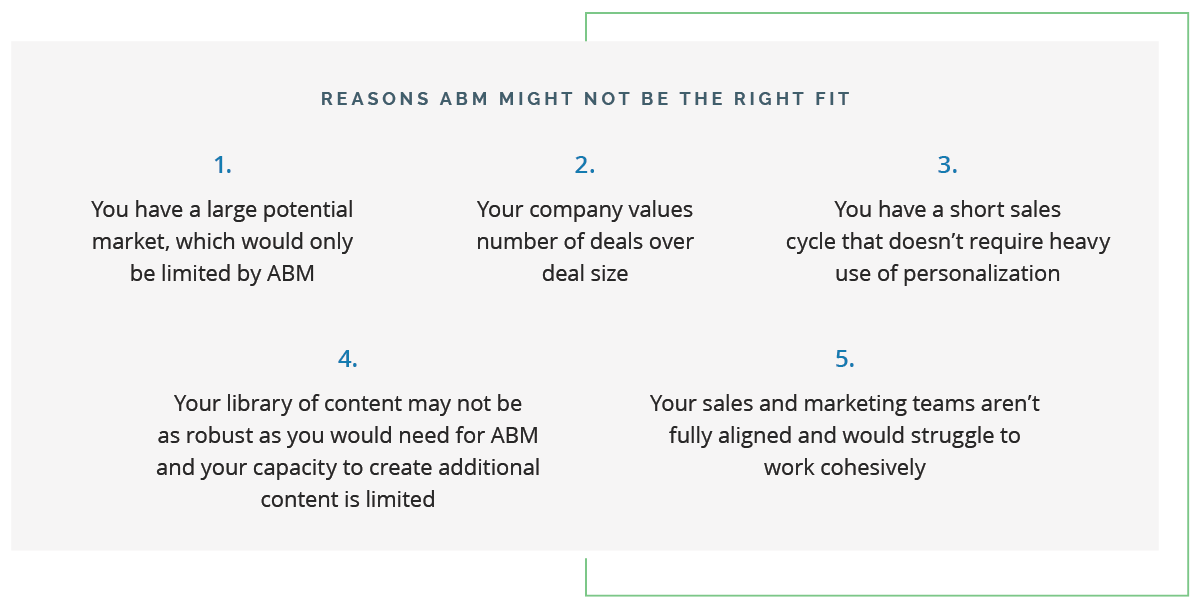
On the flip side, if you find a core segment of unique, high-value accounts that are clearly distinguished from the rest, that could be a sign ABM is your yellow brick road to revenue and reward.
So what if you’ve determined that ABM is the best path forward? If you’re just getting started, ABM can be overwhelming and won’t happen overnight. Our suggestion? Take a crawl, walk, run approach.

What Companies Get Wrong with Account Based Marketing
ABM is a hyper-specific form of marketing that requires buy-in from both your sales and marketing departments. Without this buy-in, the probability of success decreases drastically.
However, that certainly isn’t the only mistake made when it comes to ABM. Missteps can cost revenue and knowing what to look out for before you launch your ABM strategy can help avoid disaster down the road:
- Going too narrow or staying too broad.
- Assuming sales and marketing understand why specific accounts were selected.
- Treating ABM accounts like typical sales accounts.
- Failing to set regular meetings between sales and marketing.
- Continued misalignment in the form of sales not using the appropriate marketing collateral and/or marketing not listening to and incorporating feedback from sales.
Account Based Marketing Examples: ABM at Work
When ABM is successful, it can be hugely beneficial both in terms of revenue and in terms or future growth.
Client A: A cyber security company
Why They Were Successful With ABM: This client held weekly stand-up meeting with both sales and marketing, in which they spoke about the industry at large (trends, latest news, etc.) and the target account(s) within those industries, keeping everyone on the same page.
What You Can Learn: We call this the why behind the why. Because their sales and marketing teams were so aligned and continued to actively work together, both teams innately understood two distinct things:
- Why target accounts were selected and how to approach the specific accounts.
- Why and how targeting these accounts impacted the overall business, helping to achieve strategic goals.
Client B: Tata Communications (A Digital Ecosystem Enabler)
Why They Were Successful With ABM: Tata Communications shifted their focus from simply generating as many leads as possible to specifically targeting high-value accounts. A move which allowed their team of account managers, in conjunction with ISS support, to personalize outreach specific to each account, leveraging multiple touchpoints and channels to drive results.
What You Can Learn: Targeted, account-specific outreach across multiple touchpoints is the cornerstone of Account Based Marketing – a personalized approach to drive high-value results.
Sales and Marketing Alignment: The Strategy Behind Your Strategies
So, what’s the secret behind successful Account Based Marketing (and countless other strategic initiatives targeting top accounts)?
The answer is simple (and can be applied to any number of strategies): Sales and marketing alignment.
Why? Because while historically these two departments have felt separated by a divide as large as the Grand Canyon, the reality is, they are just two pieces of the same (customer-facing) pie.

To get a better understanding of why this alignment is so critical – and so much more useful than any one singular strategy – let’s look at it from the customer’s POV.
As a potential new customer, it is unlikely that you would ever solely interact with just sales or just marketing. Instead, your journey is probably more of a fusion – and it might look a little something like this: You read a blog that one of your industry peers shared, a salesperson connects with you on LinkedIn and sends you a relevant eBook, you have a few conversations, attend a webinar, and then sit down to discuss your pain points and possible solutions.
Throughout that interaction, neither sales nor marketing was the shining superstar. And rightly so. Because like any great duo will tell you, scoring your next winning account takes teamwork.
Finding your strategic approach to closing target accounts is the natural next step after aligning your teams. And one that leads many to assume they should be using Account Based Marketing (ABM). Which could be true for you, or you might be better off choosing another strategy that allows you to target a more widespread audience with less manpower.
6 More Strategies to Win Top Accounts
But hey, what if ABM isn’t the right strategy for you? What then? Luckily, we’ve got 6 other strategies proven to win top accounts and generate bottom-line impact.
An important note to remember as you read through these strategies: some strategies may leave you asking, “hey, isn’t this ABM?” Remember, the key difference between these strategies and ABM is the focus on multiple top-tier accounts vs. one specific top-tier account. Removing the explicit personalization required for ABM allows for a broader reach across strategies and channels that may be more appropriate for your company.
1. Paid Ads (Social and Digital): Putting Your Money Towards Top Results
Sometimes, putting some budget behind your marketing really pays offs. Paid ads can come in a variety of shapes, sizes, and channels. But the one thing all paid ads have in common, and the reason marketers love them? Targeting.
How to Get it Right
While paid ads can be run based simply on segmentation rules set around a specific criterion (demographics, location, job title), many ad channels allow you to upload a list of targeted contacts or accounts. Why is this our recommend approach? Because it allows you to precisely match your messaging to a group of (or all) your target accounts, creating contextual relevance for the audience and helping you avoid unqualified leads.
It is important to note, many channels require a minimum number of contacts to run an ad with a targeted list. Should you find your list doesn’t quite meet that number, you do have the option to use a lookalike audience on some platforms. While you can’t ensure that the lookalike audience will be an exact match for your target accounts and personas, it should be a close enough match to render the ad effective.
How to Get Started
It’s almost too easy to lose money running paid ads without ever seeing a real return. How do you keep the costs low and the return high?
- Setting your budget: Like any good financial planner will tell you, creating a budget is the best way to keep spending low. And in the world of paid ads, where channel costs can vary drastically, it will also help determine the right channels to go after.
- Selecting your audience: The next biggest factor is your audience. Knowing the channels, they frequent will help guide your decision-making, and help you avoid spending hundreds on a Twitter ad that your target accounts will never see.
- Informing your sales team: Keeping your sales team informed on your current roster of paid ads will avoid any unnecessary confusion should a lead call in asking for more information about “that ad I saw on LinkedIn the other day.”
Benefits
- Can be extremely targeted with messaging and promotion
- Easy to track metrics
- Fairly high click-through rates
Challenges
- Will require a monetary investment
- Ad platform, messaging, and creative can drastically impact results
- Meeting the minimum requirement for number of contacts\
An Example of a Paid Ad that Works & Why
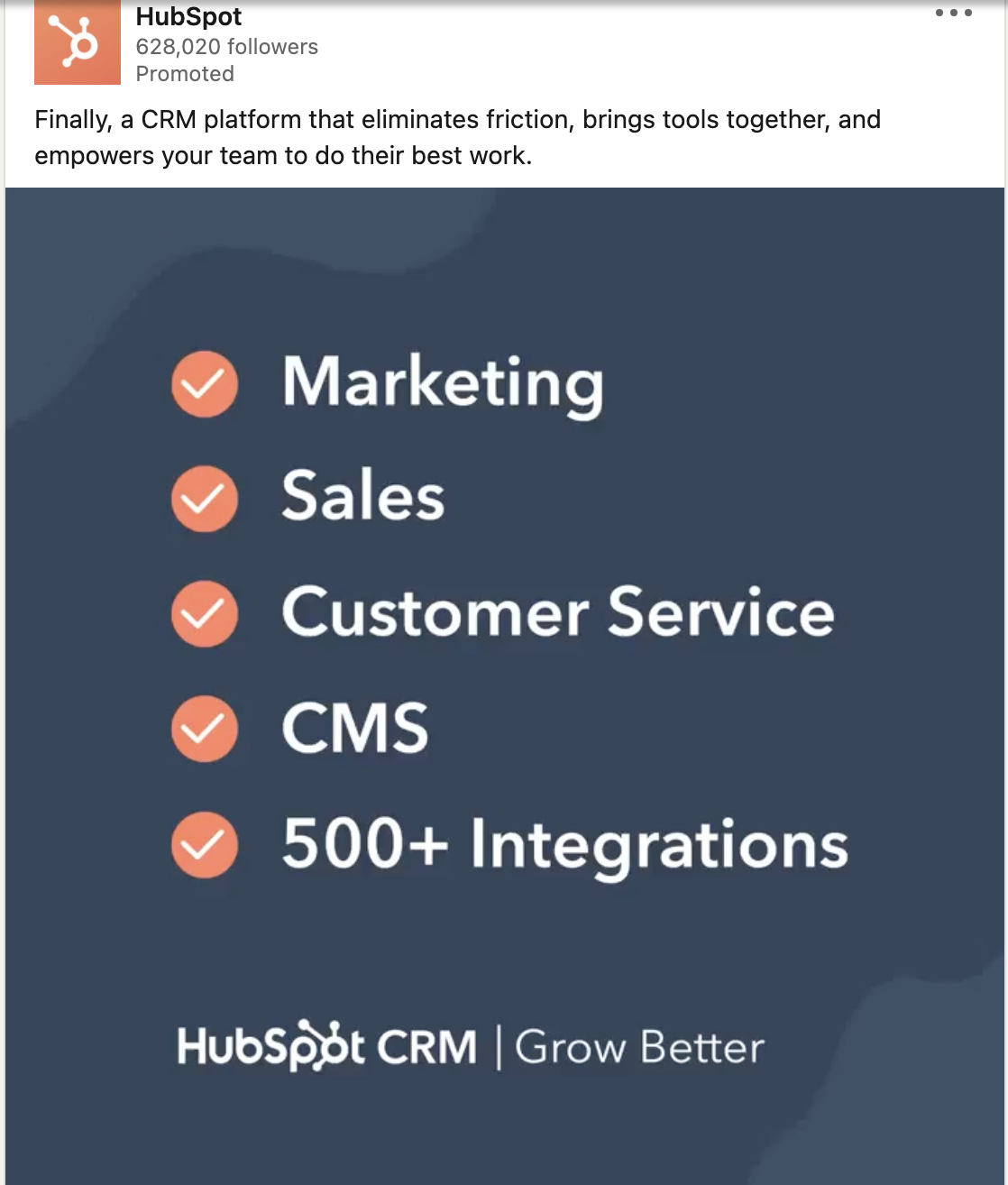
HubSpot is a big company with a big budget, but no matter what size company you have, there are a few key lessons you can apply to your paid advertisements.
- The copy is succinct and targets a set of clear and specific pain points in a conversational manner
- Although the screenshot is static, HubSpot used a Gif to make the post interactive and eye-catching
- It links to a relevant landing page with key information
2. Directing Your Outreach and Calling Strategies Towards Key Accounts
One phone call does not a sale make. However, integrating targeted direct outreach into your overall marketing and sales efforts (or cadence) will help to speed up the sales process, turning cold leads into warm prospects and eventually paying clients. If you’ve been in B2B sales for a while, this strategy is likely one you’re already deploying.
How to Do it Right
When in doubt remember, WIIFM.
The “What’s in It for Me” will be your guiding light in your direct outreach. Because the person on the other end of the line doesn’t know your company yet and won’t care about a regurgitated list of product features and benefits. What they will care about? What’s in it for them. How you can help solve a significant pain point or an everyday challenge. And when you know your lead and can seamlessly navigate between challenge and solution, the conversation becomes, well, conversational
How to Get Started
Do your research and determine the right cadence for the right audience. Like we said, this will merely be one call within an overarching outreach strategy that will target multiple decision-makers at your top accounts. Insight into what specific channels should be included in your cadence, the best time to reach out, and how your target audience prefers to communicate will help avoid any hiccups along the lead to customer journey.
Bonus: By setting your cadence ahead of time, you proactively align your sales and marketing outreach efforts. Ensuring you don’t miss any major talking points or challenges that could be the key to winning that new account.
Benefits
- High-performing channel in terms of conversion
- Can speak directly to that lead’s pain points/challenges
- Allows you to quickly get to “the pitch”
Challenges
- Heavy time investment
- Must be able to speak on the fly, answer questions and personalize the conversation to the individual
- Will require multiple “touches” to convert
An Example of Direct Outreach that Works & Why
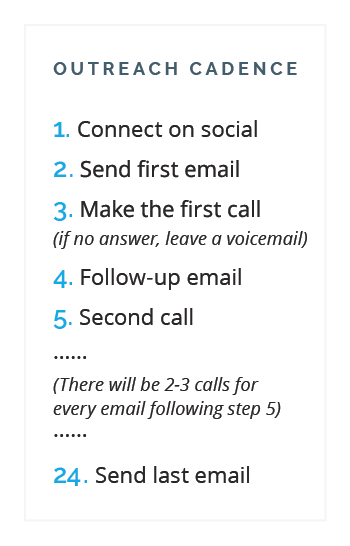
As you can see from this example, direct outreach often requires a good number of touch points and no channel stands on its own. This cadence works because:
- By the time a salesperson is calling, the prospect has a level of familiarity with their name and face
- The multi-channel approach allows the prospect to engage using the channel they are most comfortable with
- Each channel can serve a different purpose and a salesperson can use the channel to suite their specific needs, offering new information slowly instead of overwhelming the conversation with features and benefits
3. Social Media Marketing: Connecting with Top Accounts
In today’s market, you would be hard pressed to a find a brand that isn’t on social media. But simply maintaining an account isn’t enough. And if you aren’t aligning your sales and marketing efforts, you may find yourself spending hours posting, commenting, and sharing, without ever making that valuable connection with one or more of your top accounts.
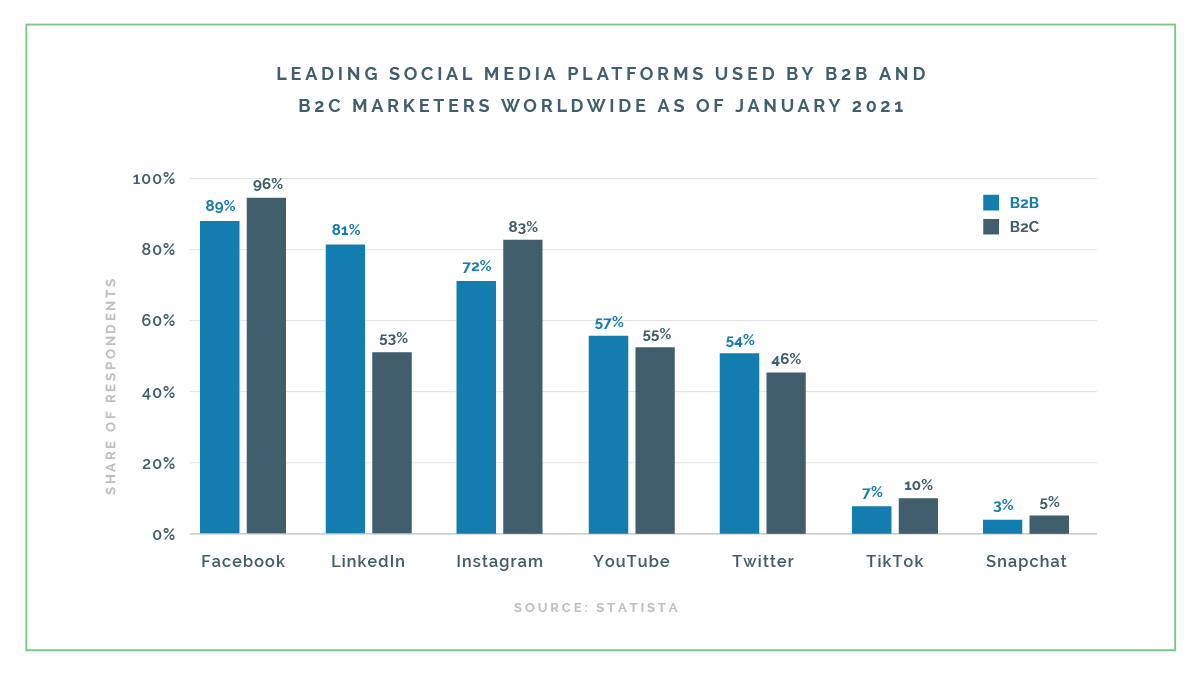
How to Get it Right
Social feeds are clogged with brands promoting their products, giving a perspective on a new article, or sharing their favorite GIF. And with so much competition literally directly above and below you in the feed, your top accounts (and associated decision-makers) are most likely scrolling right past you.
How do you change that?
Aligning your sales and marketing efforts to create a one-two punch.
- Main Feed: Marketing controls the main feed for your company, which should act as a sort of home-base, providing relevant content, information, and promotion. And the only way to really do that well is with direct feedback from the sales team members who are actively engaging with and seeing the feeds of your targeted accounts.
- Direct Outreach: At the same time, your sales team members should be directly connecting and engaging with the decision-makers at your top accounts, sharing articles from your main feed, commenting on a decision-maker’s post with their own unique perspective, and leveraging their personal channels to share industry-related articles and updates.
How To Get Started
You’ve probably had your main accounts up and running for years now, but if you’re just getting started aligning your sales team’s social selling efforts with your marketing team’s social media marketing efforts, we’ve got a few pieces of advice to help your teams get aligned and get connecting:
- Create rules and best practices: Your sales team (and their social accounts) directly represent your brand, which means it may be beneficial to establish some guidelines for how to use their accounts, what is appropriate to post, and any no-go’s when it comes to sharing.
- Pick the right social media management platform: While some social media management platforms are limited to simply scheduling posts, others are more holistic. These holistic platforms include features that allow your marketing team to curate content for the sales team to share on their feeds, saving your sales team time and effort and ensuring consistency with the kind of content being shared from your primary brand accounts.
- 3×3 Research Method: Maybe your sales team is new to the social game and hasn’t had the best luck with decision-makers accepting their connection or request. The 3×3 research method is all about finding relevant content to share with target accounts, thereby increasing your chances of the new connection actually connecting. It works like this: Find 3 pieces of relevant content in 3 minutes, personalize the content to the recipient, and hit send.
Benefits
- Fairly easy to get up and running
- Offers direct access to decision-makers at target companies
- One of the easiest channels to grow your audience and leverage content to grow your thought leadership
Challenges
- It’s easy to get lost in “the shuffle” if your messaging isn’t crisp and relevant
- Conversion rate isn’t typically as high through social channels
- Each platform is unique and serves a different purpose depending on your target audience. You’ll need to find the right mix of channels and tailor your messaging and approach to each channel specifically
An Example of Social Media Marketing that Works & Why
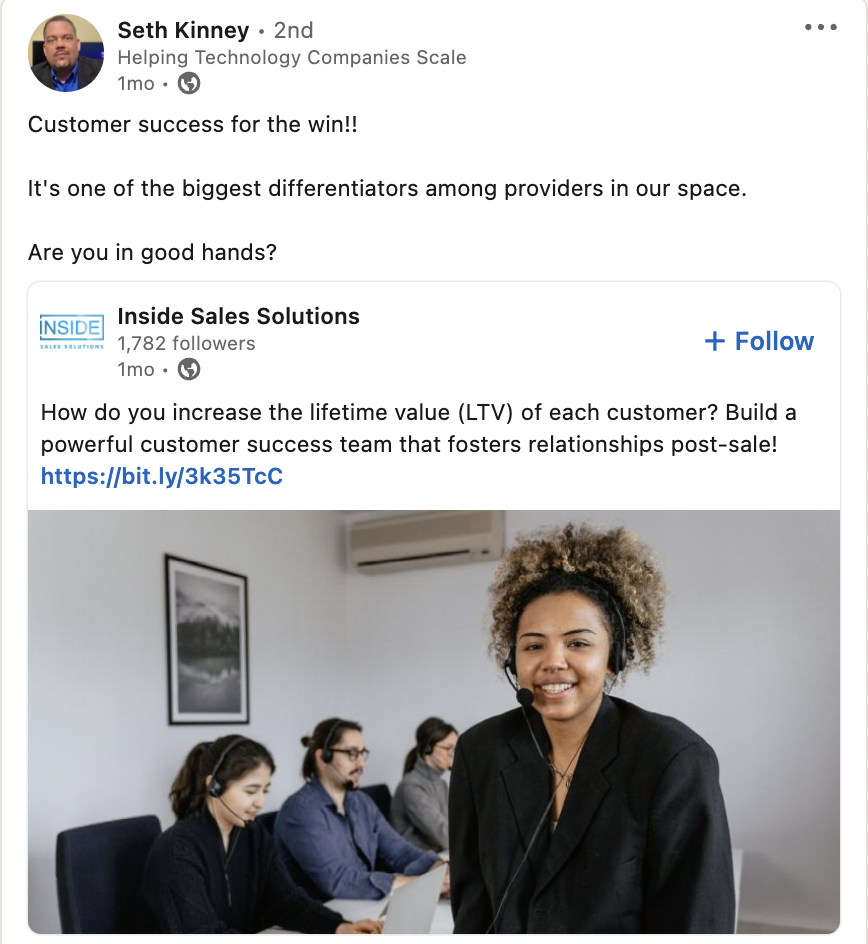
Yes, we’re tooting our own horn. But for good reason. This post works because:
- The post originated from the main feed, but was relevant enough for a salesperson (or VP of) to share on their own feed
- Seth added his own commentary to make it personal and engaging for his feed, sparking a conversation or two from his audience
- It answers the WIIFM in a few clear lines (in this case increasing customer lifetime value)
4. Finding the Right Inbox for Your Email Marketing Strategy
Email marketing can be shockingly controversial. Every day it seems a new article comes out either promoting its effectiveness or pronouncing its upcoming demise. However, with the right strategy, and a little bit of creative flair, your next email campaign could be the push your target account needs to request a demo.
How to Get it Right
Successful email marketing is dependent on two critical factors: your contact list and your content.
- The contacts: If you haven’t scrubbed your email list recently, chances are your deliverability is at an all-time low. Healthy list = better deliverability and higher chance of opens and click-throughs. But while scrubbing your list is good, new opt-ins are even better. A couple of tips for getting qualified email opt-ins:
- Make sure the opt-in form is easy to find on your website
- Use your targeted paid ads to promote an industry-specific newsletter or email opt-in
- Make sure any downloadable content is accompanied by an option for that lead to opt-in to further communication around the same topic
- The content: If you don’t want your audience opting out of your next email, you need to make sure the content you’re delivering is relevant and engaging. The quickest way to get lost in the inbox is with bad content sent to the wrong audience.
Once you have your contacts and your content locked in, it’s all about segmentation—creating a nurture journey best suited to your target audience and their industry-specific needs.
Remember: Always keep your sales team up to date on any email marketing campaigns going out. Open communication means sales knows exactly where the new leads are coming from, and they can answer any questions about an offer or piece of content in the latest email.
How to Get Started
Have we mentioned enough how important a healthy email list is? If not, we’ll say it again. A healthy list is your golden ticket to email marketing success.
And the easiest way to achieve a healthy email list? Getting your sales team involved. So often a contact’s information gets entered and forgotten. Make sure your teams are updating their contacts within your CRM to help you achieve max deliverability on your next email send.
Benefits
- Direct communication with the individual
- Easy to track metrics
- Ability to create buyer’s journeys based on response
Challenges
- Standing out in a crowded inbox
- Metrics for emails have diminished and are becoming less trustworthy
- Solidifying a good email list
An Example of Email Marketing that Works & Why
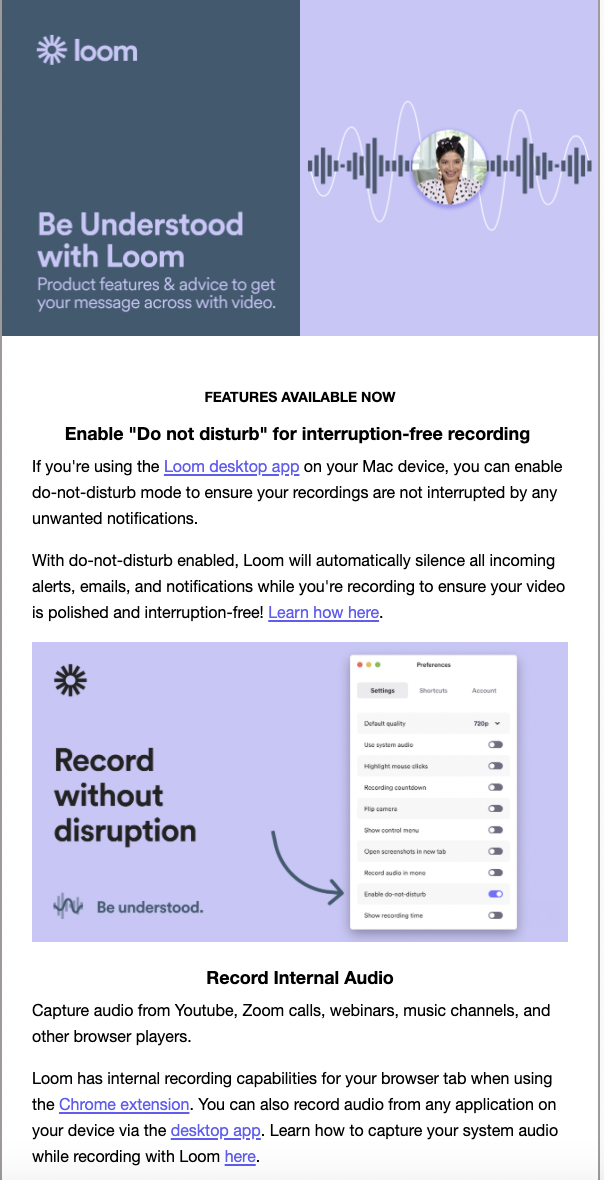
Your inbox is most likely filled to the brim with marketing emails. And your customers’ inboxes are no different. Standing out requires some strategic (and creative) thinking. Why this email works:
- The subject line is catchy
- The animation in multiple sections keeps the reader engaged
- The call-to-actions are clear and easy to navigate
5. Attending and Hosting the Events Your Key Accounts Care About
Event marketing is one of the most expensive types of marketing. And whether you’re hosting a webinar or flying a team out to a trade show, if you aren’t showing results, you probably won’t be hosting (or attending) that event next year.
How to Get it Right
When it comes to event marketing the key is knowing what events your target accounts care about and will be attending themselves. After all, what’s the point of a trade show if you aren’t making connections and setting meetings.
Online or in-person, it doesn’t matter, you need to do your research. Most events will provide a list of attendees, but this does require you to have already signed up. So, unless you can rely on previous year’s attendance records, you may need to get a little more creative in selecting what events are worth your time.
A few ways to determine if your target accounts are going to an event:
- Check out their social media: Most companies post about event attendance. See if they went last year or have posted about attending this year.
- Have your sales team bring it up in conversation: Your sales team speaks to leads and prospects every single day, this is the perfect opportunity to garner interest in an upcoming event.
- Leverage interactions at earlier events: See a target account at an event? Find out if they are also attending an upcoming event. Not only will this tell if you that investment is worth it, but it gives you a reason to follow-up at that next event.
Bonus: Hosting an event? Invite target accounts and show off your expertise in the industry. You may not become a thought-leader with one webinar, but you can show a new prospect that you have the chops (and the know-how) to solve their challenges.
How to Get Started
Well before you schedule the webinar or coordinate flights to the trade show, you need to establish your event marketing plan – laying out your best practices and guidelines for pre-event promotion, event coordination, and post event follow-up.
Things to consider in your event marketing plan:
- The goal or objective of your event or the event you are attending
- The target audience
- The relevant value-add you’ll offer attendees
- Any post event nurture journey
Benefits
- Interact/engage directly with your audience and answer any questions in the moment
- Define yourself/your company as a thought leader in the space
- Delivers quality list of prospects interested in your company
Challenges
- High investment of time and money
- Must be highly relevant to keep audience’s attention
- Behind-the-scenes coordination, including technology alignment and schedule management
An Example of Event Marketing that Works & Why
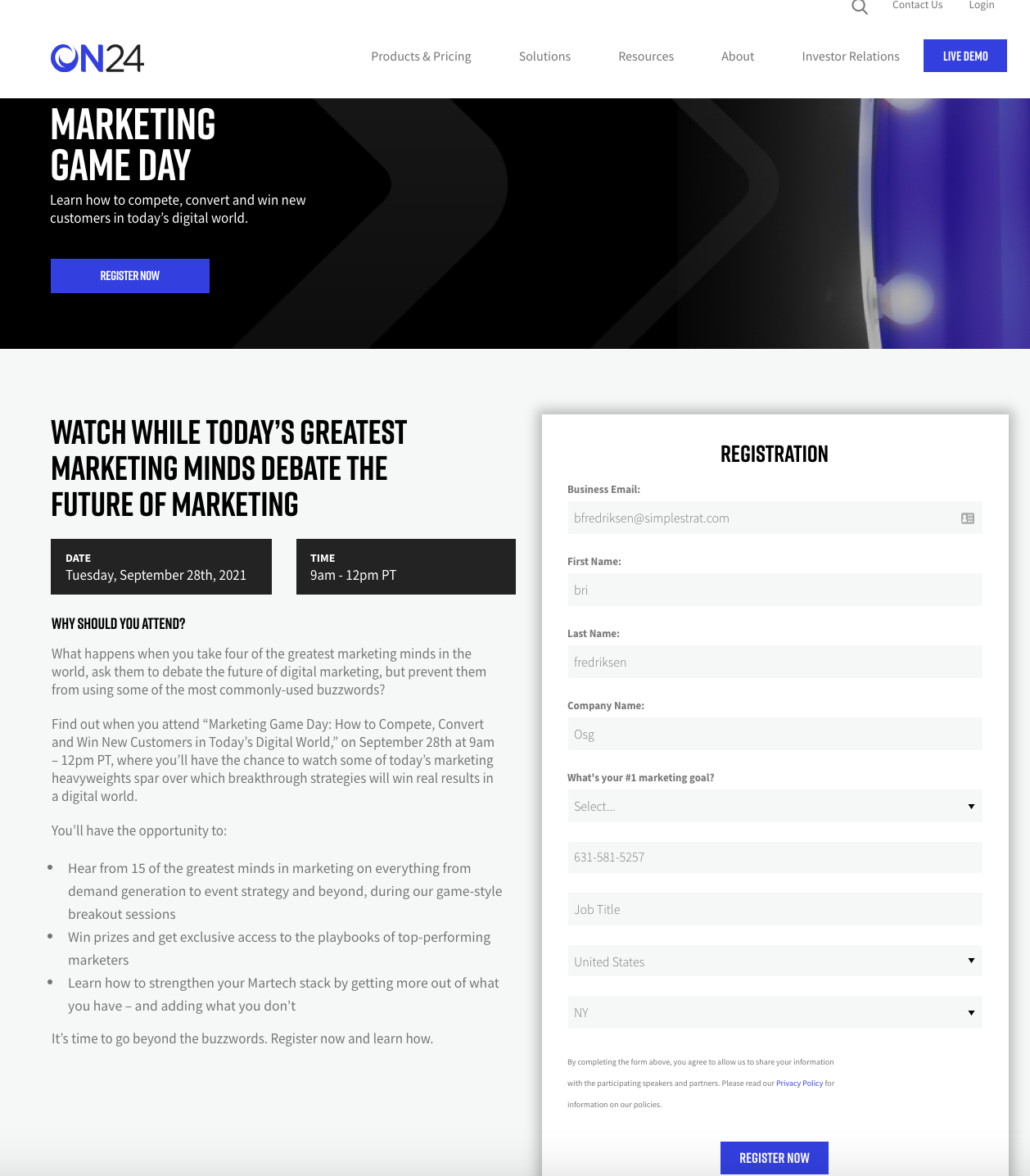
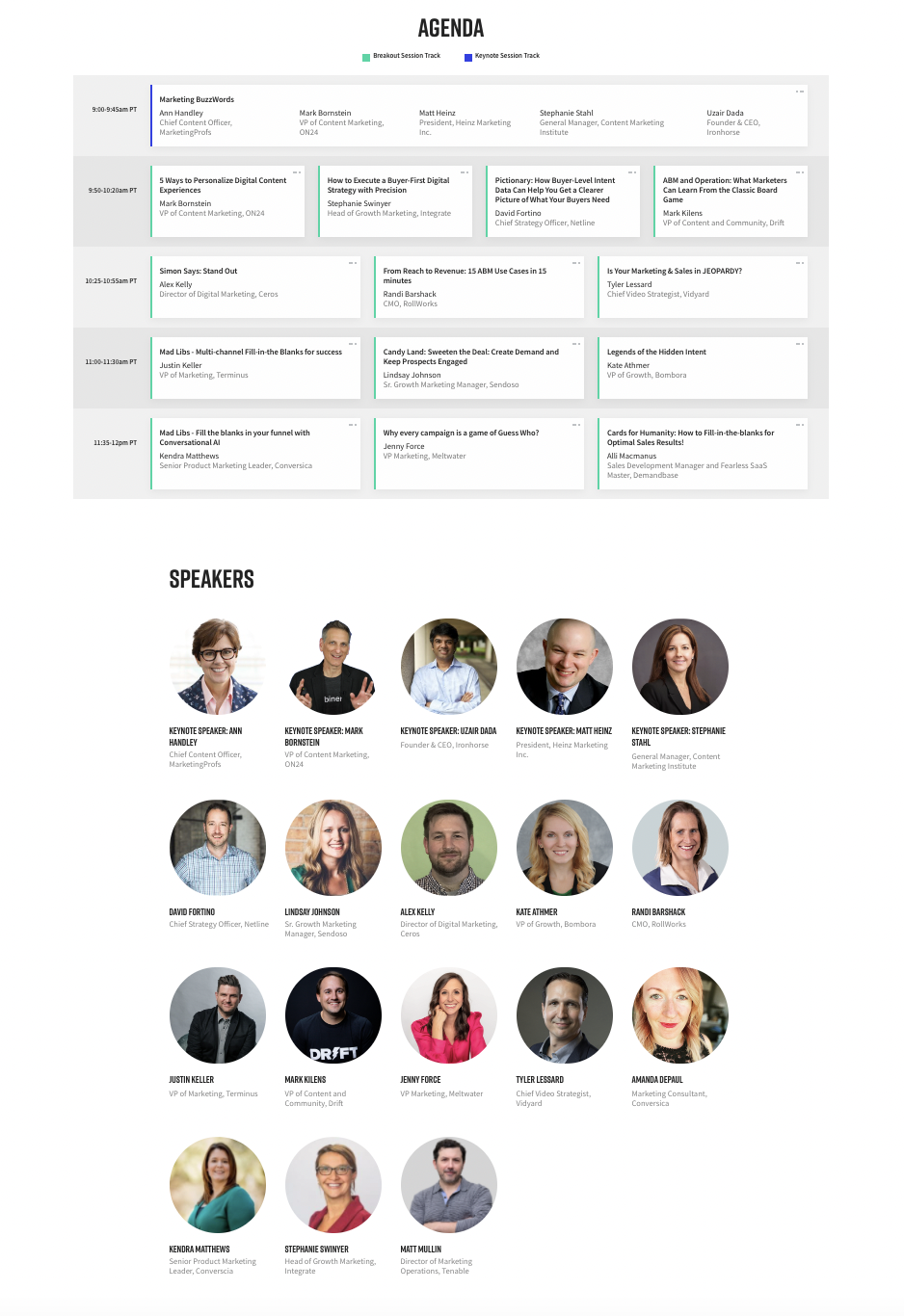
On24 is itself a webinar platform, so we would expect nothing but the best from them. Here’s why their event marketing works:
- Offers a clear value-add with a promise of exclusive access to relevant content
- Showcases the speakers and leverages their expertise (and name power) to draw a crowd
- Lays out exactly what will be covered and what attendees can expect to learn from attending the event
6. Optimizing Your SEO Strategy for Real Results
Think back to the last time you Googled something. Did you go past the first page? Chances are you probably clicked on one of those top-ranking results. And guess what? Your target accounts are doing the exact same thing. Which means if you aren’t showing up on that first page, in your audience’s mind, you don’t exist.
How to Get it Right
Finding yourself on the first page of Google takes time and effort and it all starts with selecting the right keywords. Because of that, keyword research is and will remain an essential aspect of your SEO strategy. Specifics like search volume and keyword difficulty will help guide your decision and ensure your efforts aren’t wasted.
But in order to be really effective, your keyword(s) needs to be representative of your audience and how they would speak about or search a term/question. And that’s where your sales team comes in. Think of sales as an encyclopedia of customer insight and information. They know:
- How the customer speaks
- What they speak about
- Who their trusted resources are
- Why they do business with you
That primary research is gold, and your marketing team should be including it in their keyword research, guest post outreach, and overall SEO strategy.
Note: As any SEO expert will tell you, keyword research is just the tip of the iceberg when it comes to optimizing your SEO strategy. A good strategy takes work, and a lot of it. Ready to dig in a little more? These SEO resources will help guide your strategy and get your keywords working for you:
- HubSpot’s How to Create an SEO Strategy for 2021 [Template Included]
- SEMRush’s How to Create an Effective SEO Strategy
How To Get Started
Beyond talking with your sales team, there are a variety of (free) resources and research methods that will help you determine the kinds of keywords and phrases which will yield the best results for your SEO efforts. A few options include:
- Comments in social media groups or on YouTube videos
- Amazon reviews
- Questions or comments left on your competition’s articles, social posts, etc.
Benefits
- Increases traffic to your site
- Will match your relevant content with the appropriate audience and their search queries
- Does not require a monetary investment
Challenges
- Determining the appropriate and relevant keyword(s)
- Existing brands outranking you for those search terms
- Will take some time to build up your rank and appear on page 1 of Google
An Example of SEO That Works & Why
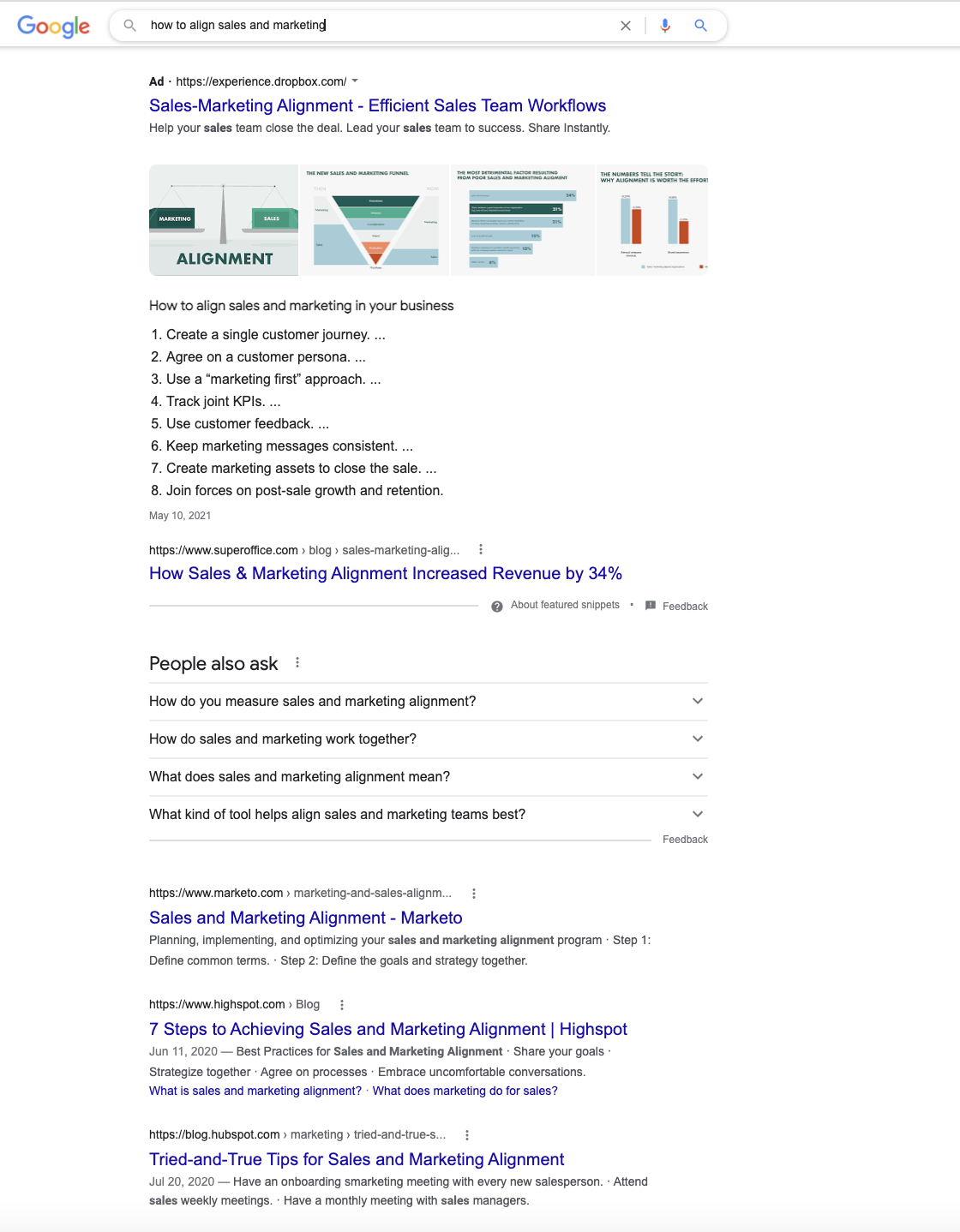
Getting on the first page of Google is like scoring the winning touchdown or hitting a home run. How did these companies do it?
- Directly answered the question within the search query
- Laid out the article with easy-to-follow H1, H2, and H3 headlines
- Included relevant graphics and links to supporting material
Conclusion
None of these strategies function in a silo. Chances are, you’ll employ multiple strategies at various times depending on your needs and your overarching business goals. However, what will remain is the need for sales and marketing to strategically align and work together to achieve your targeted goals.
Need a little help?
Inside Sales Solutions has made it our job to seamlessly blend sales and marketing, offering our clients strategies that attract, qualify, and convert leads into customers. With over a decade in outsourced sales development, we understand how important a qualified lead is to a sales team and we’ve built out a robust marketing solution that generates leads and ultimately revenue – monetizing the marketing cost center to help you achieve your strategic business goals.
Ready to sit down and discuss one (or more) of these strategies? Schedule a call today.
Want to share this guide or save it for later?

